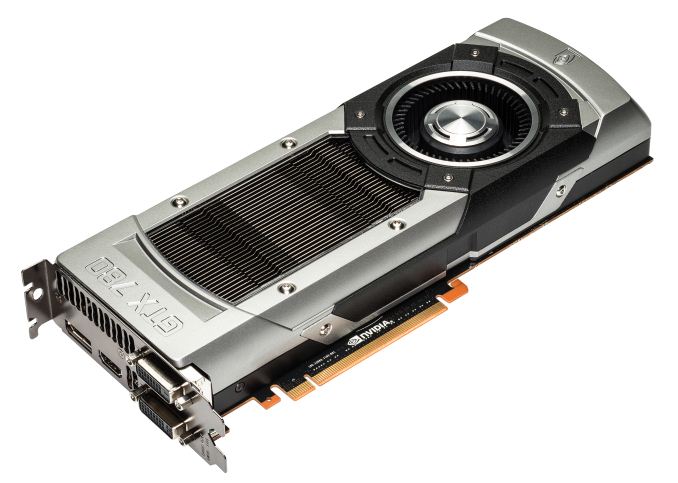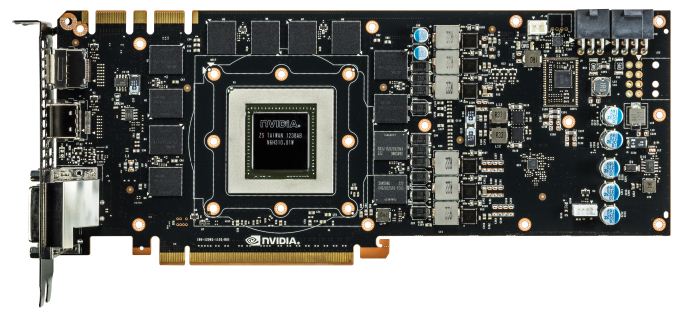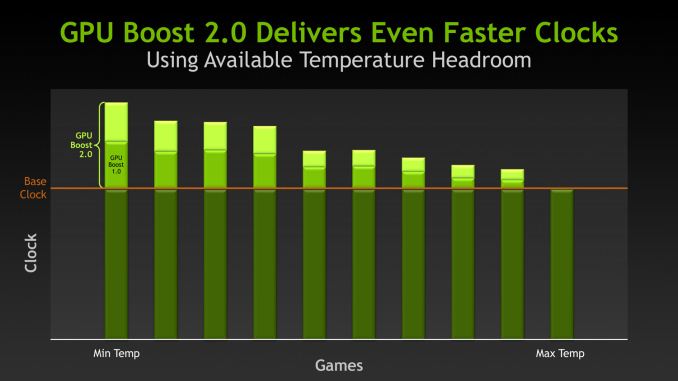NVIDIA GeForce GTX 780 Review: The New High End
by Ryan Smith on May 23, 2013 9:00 AM ESTMeet The GeForce GTX 780
As we previously mentioned, the GTX 780 is very much a Titan Mini in a number of ways. This goes for not only the architecture, features, and performance, but as it turns out it will be the case for the design too. For the reference GTX 780 NVIDIA will be straight-up reusing the GTX Titan’s board design, from the PCB to the cooler, and everything in between.
As a result the reference GTX 780 inherits all of the great things about the GTX Titan’s design. We won’t go into significant detail here – please read our GTX Titan review for a full breakdown and analysis of Titan’s design – but in summary this means we’re looking at a very well built blower design almost entirely constructed out of metal. GTX 780 is a 10.5” long card composed of a cast aluminum housing, a nickel-tipped heatsink, an aluminum baseplate, and a vapor chamber providing heat transfer between the GPU and the heatsink. The end result is that the reference GTX 780 like Titan before it is an extremely quiet card despite the fact that it’s a 250W blower design, while it also maintains the solid feel and eye-catching design of GTX Titan.
Drilling down, the PCB is also a re-use from Titan. It’s the same GK110 GPU mounted on the same PCB with the same 6+2 phase power design. This is part of the reason that GTX 780 has the same TDP as GTX Titan, while at the same time giving GTX 780 as much or more TDP headroom than Titan itself. Using the same PCB also means that GTX 780 has the same 6pin + 8pin power requirement and the same display I/O configuration of 2x DL-DVI, 1x HDMI, 1x DisplayPort 1.2.
Also being carried over from Titan is GPU Boost 2.0, which was first introduced there and has since been added to additional products (many GeForce 700M products already have it). GPU Boost is essentially a further min-maxed turbo scheme that more closely takes into account temperatures and GPU leakage characteristics to determine what boost bins can be used while staying below TDP. It’s more temperature dependent than the original GPU Boost and as a result more variable, but in cooler situations it allows tapping into that thermal headroom to hit higher clockspeeds and greater performance, TDP allowing. At the same time this means GTX 780 also gains GPU Boost 2.0’s temperature target functionality, which allows users to cap boost by temperature as well as TDP. As with Titan this limit is 80C by default, with the idea being that adjusting the limit is a proxy for adjusting the performance of the card and the amount of noise it generates.



















155 Comments
View All Comments
Akrovah - Friday, May 24, 2013 - link
Oh yeah, forgot audio data, all of which gets stored in main RAM. And THAT will take up a pretty nice chunk of space righ there.Sivar - Thursday, May 23, 2013 - link
You realize, of course, that the 8GB RAM in consoles is 8GB *TOTAL* RAM, whose capacity and bandwidth must be shared for video tasks, the OS, and shuffling the game's data files.A PC with a 3GB video card can use that 3GB exclusively for textures and other video card stuff.
B3an - Friday, May 24, 2013 - link
See my comment above.DanNeely - Thursday, May 23, 2013 - link
Right now all we've got is the reference card being rebadged by a half dozenish companies. Give it a few weeks or a month and I'm certain someone will start selling a 6GB model. People gaming at 2560 or on 3 monitor setups might benefit from the wait; people who just want to crank AA at 1080p or even just be able to always play at max instead of fiddling with settings (and there're a lot more of them than there are of us) have no real reason to wait. Also, in 12 months Maxwell will be out and with the power of a die shrink behind it the 860 will probably be able to match what the 780 does anyway.DanNeely - Tuesday, May 28, 2013 - link
On HardOCP's forum I've read that nVidia's told it's partners they shouldn't make a 6GB variant of the 780 (presumably to protect Titan sales). While it's possible one of them might do so anyway; getting nVidia mad at them isn't a good business strategy so it's doubtful any will.tipoo - Thursday, May 23, 2013 - link
If a slightly cut down Titan is their solution for the higher end 700 series card, I wonder what else the series will be like? Will everything just plop down a price category, the 680 in the 670s price point, etc? That would be uninteresting, but reasonable I guess, given how much power Kepler has on tap. And it wouldn't do much for mobile.DigitalFreak - Thursday, May 23, 2013 - link
The 770 will be identical to the 680, but with a slightly faster clock speed. I believe the same will be true with the 760 / 670. Those cards are probably still under NDA, which is why they weren't mentioned.chizow - Thursday, May 23, 2013 - link
Yep 770 at least is supposed to launch a week from today, 5/30. Satisfy demand from the top-down and grab a few impulse buyers who can't wait along the way.yannigr - Thursday, May 23, 2013 - link
No free games. With an AMD card you also get many AAA games. So Nvidia is a little more expensive than just +$200 compared with 7970GE.I am expecting reviewers someday to stop ignoring game bundles because they come from AMD. We are not talking for one or two games here, for old games, or demos. We are talking about MONEY. 6-7-8-9-10 free AAA titles are MONEY.
Tuvok86 - Thursday, May 23, 2013 - link
I believe nVidia has bundles as well